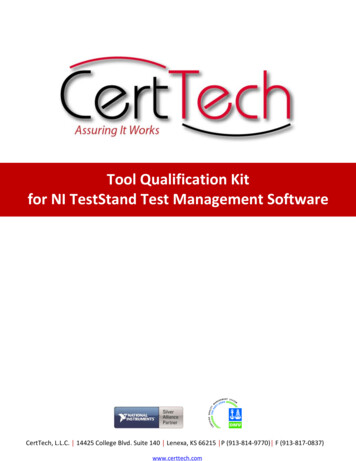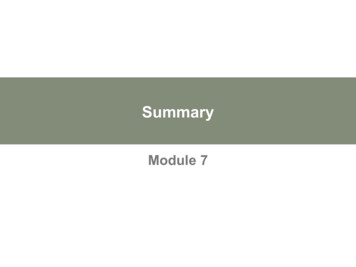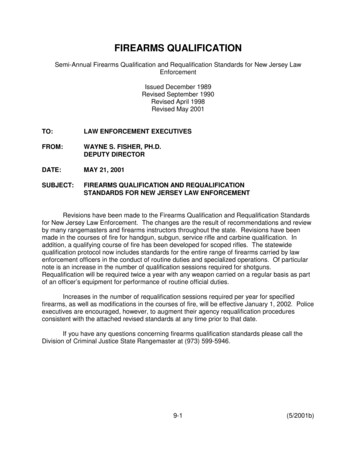
Transcription
Tool Qualification Kitfor NI TestStand Test Management SoftwareCertTech, L.L.C. 14425 College Blvd. Suite 140 Lenexa, KS 66215 P (913-814-9770) F (913-817-0837)www.certtech.com
CertTech’s TestStand Qualification Kit provides a solid foundation forachieving formal qualification of the National Instrument’s TestStand Toolused for automated product verification and validation testing in rigorousregulatory environments.OverviewVerification and Validation (V&V) are critical process elements of the product lifecycles used in safety or mission critical software, hardware and system development.This is particularly important in regulated industries, such as medical devices,pharmaceuticals, rail transportation, aerospace and military applications, which mustadhere to rigorous process guidelines to achieve approval by regulatory agencies andcertification authorities.Effective use of test automation can save significant time and effort in complexdevelopment projects, and is encouraged by regulatory authorities as a means ofreducing human error that is inherent in the process. Qualification of the testautomation tools allows for the tool outputs to be trusted as true and correct, andeliminates the need for costly and time consuming manual review and analysis ofthe test tool outputs.Test automationcan maximize thespeed, efficiencyand flexibility oftesting and its useis encouraged byregulatoryauthorities toreduce errors.The ChallengeThe use of tools to eliminate, reduce or automate processes in the productdevelopment lifecycle is common in many companies across multiple industries.Tools are typically categorized for either development or verification activities andappropriate qualification processes are defined for each. Development tools produceoutputs that become part of the product itself, and therefore can introduce errors ordefects in the product design. Verification tools do not produce outputs that becomepart of the product, and therefore cannot introduce defects or errors in the productdesign. They may, however, fail to detect defects or errors.Here is the real challenge; in accordance with DO-178B/C and other regulatoryguidelines, verification tools such as NI’s TestStand must be qualified if any requiredregulatory processes are eliminated, reduced or automated. Qualification ofdevelopment tools typically requires the same level of process rigor applied to theproduct development artifacts. Qualification of verification tools generally involvescreation of a qualification plan, definition of operational requirements, verification ofthe requirements, and maintaining the tool artifacts in a suitable configurationmanagement system.1Verification toolssuch as TestStandmust be qualifiedif any regulatoryprocesses areeliminated,reduced orautomated.
The SolutionCertTech LLC has created a qualification kit for NI’s TestStand. We have extensiveexperience in regulated industries and functional safety standards and thoroughlyunderstand the requirements for using qualified tools specified by standards like DO178C and ISO 26262.The TestStand Tool Qualification Kit can significantly reduce the time and cost offormal tool qualification by: Supporting tool qualification processes for DO-178C, ISO 26262 and otherregulations. Providing a comprehensive set of requirements and test coverage for commonTestStand features. Delivering an extensive suite of tests verifying the provided requirements. Offering a readily extendable framework that allows for coverage extension asneeded. Providing often required TQP, TOR, TQAS, test trace matrix and reviewdocumentation.The TestStandTool QualificationKit significantlyreduces the timeand cost of formaltool qualification.The Tool Qualification Kit also produces the documentation that will be needed as thenecessary artifacts for compliance. This documentation is essential because theoverall goal is to show complete transparency for the verification process so the testcan be recreated and every detail is clear on what was done. The Kit providestremendous value to companies across a wide variety of safety and mission criticalindustries, where rigorous product development processes demand the highest levelsof assurance.With some of the newer functional safety standards like ISO 26262 and DO-178C,there is specific information requiring the projects to use ‘qualified tools’ forverification and validation activities that will not be manually reviewed, whichinherently places additional emphasis on using qualified tools like NI TestStand---andthe TestStand Tool Qualification Kit.Below is a listing of the Tool’s contents; Generic Tool Qualification Plan (TQP) Generic Tool Operational Requirements (TOR)- Station configuration, report options, data types- Sequence file properties, sequences, variables, parameters- LabVIEW, LabWindows CVI and C/C Adapters- Expressions operators and functions- Step properties, steps using adapters, sequence calls, flow control,statements, labels, message pop-ups and waits Requirements-based Verification Procedures Generic Tool Qualification Accomplishment Summary (TQAS) document Test Trace Matrix providing correlation of requirements with specific tests Sequence for running the qualification tests and generating pass/fail results Individual sequences for testing the features of TestStand2
Cost AnalysisThe examples below detail the average internal costs involved in tool qualification by projectsize, compared to use of the TestStand Tool Qualification Kit. Expense line items will vary.Project SizeSmallMediumLargeLargerAverage Product Life ExpectancyAverage Revision Cycle30 yrs5 yrs30 yrs5 yrs30 yrs5 yrs30 yrs5 yrsRevision Cycles Through Product LifeAverage Code Size (KSLOC)*62567561506300Average Test Results Review TimeIn Hours Per 1 KSLOC2222Burdened Labor Rate Per Hour ** 75 75 75 75Expense of Review Time(#KSLOC x 2hrs x Rate x Cycles) 22,50067,500 135,000 270,000Cost of the Tool Qualification Kit*** 24,999 24,999 24,999 24,999Cost Savings( 2,499) 42,501 110,001 245,001Footnotes*KSLOC; 1000 Source Lines of Code** Estimated fully burdened labor rate for experienced software engineer, DO-178C, Level A; 150,000 USDper year, 75/hr.*** Further pricing information available upon contact.**** Savings do not reflect ongoing revision service costs.DER Compliance Statement*“The TestStand tool is used to automate the collection and analysis of test data during requirementsbased verification testing activities and complies with all applicable process and documentationrequirements for Verification Tools as defined in section 12.2 of RTCA/DO-178B and FAA Order 8110.49Chapter 9, as well as Section 12.2 of RTCA/DO-178C and RTCA/DO-330. The tool qualification artifactsincluding the Tool Qualification Plan (TQP), the Tool Operational Requirements (TOR), the TestProcedures and Verification Results (TPVR), the raw test result files (actual and expected), and this ToolQualification Accomplishment Summary (TQAS) have been archived in accordance with the applicableconfiguration management processes and procedures, and are available for review.”*”Summary of Compliances/Findings/Observations Report for CertTechTestStand Tool Qualification Kit.”thJuly 27 , 2012; Mr. Thomas C. Roth, FAA, Designated Engineering Representative (DER).3
Significantly Reduce the Time and Cost of Formal Tool QualificationAn Experienced PartnerCertTech has extensive experience providing high quality V&V services in a variety of regulatoryenvironments, including formal qualification of software development and verification tools used toincrease efficiency of the product development and certification processes.CertTech’s team of engineering professionals provides innovative products, systems and services insupport of the development of advanced technology products, focusing primarily on the developmentof automated test solutions.14425 College Blvd., Suite 140Lenexa, KS 66215913-814-9770www.certtech.comNational Instruments, NI and ni.com are trademarks of National Instruments. CertTech, CertTech, LLC and certtech.com are trademarks ofCertTech, LLC. Other product and company names listed are trademarks or trade names of their respective companies.4
requirements for Verification Tools as defined in section 12.2 of RTCA/DO-178B and FAA Order 8110.49 Chapter 9, as well as Section 12.2 of RTCA/DO-178C and RTCA/DO-330. The tool qualification artifacts including the Tool Qualification Plan (TQP), the Tool Operational Requirements (TOR), the Test










